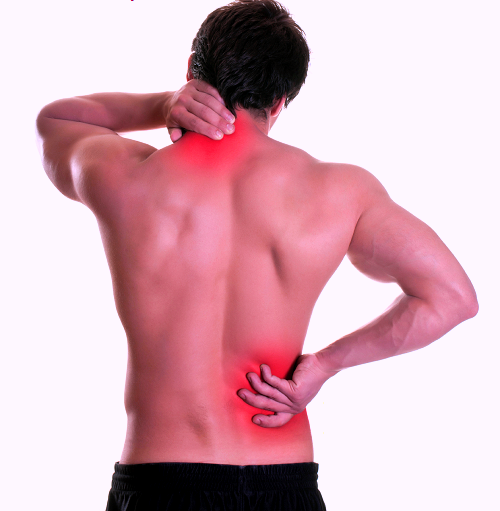As the facility provider
Accredited From The McKenzie Institute International, New Zealand
A Non-surgical superspecialisation center for Back, Neck and Joint pain.

What does research say?
What
are the risk factors in low back pain?
What about extensive
investigations?
What should you do?
Why McKenzie
How
does Original McKenzie Lumbar Roll
help?
Read on .....
Research on
Low back and neck pain
-
What are the risk factors in back, neck pain ?
During the course of their lives
70–85% of individuals will experience low back pain (LBP)
(Andersson, 1999; Deyo and Weinstein,
2001; Goodwin and Goodwin, 2000; van Tulder,
2001)
Over 80% of such patients report
recurrent episodes (Waddell, 1998, p.
103–117).
It is estimated that 80–90% of patients will have recovered within 6 weeks, regardless of treatment (Bronfort et al., 1996; CSAG, 1994; Indahl et al., 1995; Jackson, 2001; Klaber Moffett et al., 1986; Lahad et al., 1994; van Tulder et al., 1997).
Multiple studies since 1975 to recent, suggest that prolonged
sitting, is generally accepted as a risk factor in developing low
back pain.
Andersson
BJG (1981) Frymoyer JW, Pope MH, Constanza MC, et al (1980), Kelsey
JL, White AA (1980) and Kelsey JL (1975)
Kelsey 1975, suggests exposure to vibration by drivers pre-disposes to disc herniations.
Forward head posture has been linked to neck pain and headache
symptoms (Silva et al.,
2009; Fernandez-de-Las-Penas, 2007).
You are not alone in this. All that you need to do is self manage and learn the tricks of prevention as you would do with common cold and fever. Conditions such as these does not need prolonged treatments.

What about extensive investigations done for such conditions?
Pathoanatomical findings correlate poorly with levels of pain and disability (Nachemson, 1999).
The association between symptoms and imaging results has been consistently weak, and up to 85% of patients with low back pain cannot be given a precise pathoanatomical diagnosis using these methods Deyo RA, Weinstein JN, 2001
Only a small proportion (<15%) will have an underlying nerve-root compromise secondary to a herniated disc. (Deyo et al 1987)
In short,
expensive investigations are most often not essential in these
conditions, unless your symptoms seem
non-mechanical or there is a neurological
compromise.
Hence
activity and exercises play a very important role for the health of
the spine as age advances. All that is required of you is to
self manage, exercise in your directional preference to abolish
your present symptoms and take preventive care to prevent
recurrences. There is no need what so ever to take long prolonged
exercise regimes to prevent recurrences. It is all in your
hands.
Prolonged bedrest has no role in the treatment of low back or neck pain and its resulting referred or radiating symptoms to the extremities.
What should you do?
Overall, 25% of women over the age of 65 years and 40% of women over the age of 80 years have a vertebral compression fracture.(Langdon 2011, Melton et a 1989).
The aetiology of postural neck pain remains uncertain but is generally considered to be associated with poor postural awareness and habitual postures which result in greater load on the supporting structures (Farfan, 2000, Neumann, 2002).
It is increasingly recognized that timely resumption of physical activity is critical to successful rehabilitation (van Tulder MW, Koes B, Malmivaara A. 2006).
Why McKenzie
Edmonston, Song,Bricknell, Davies, et al 2000 in a study using MRI evaluation of the lumbar spine suggested and reinforced the clinical concept that decisions in relation to direction of movement, or spinal position, should be based on symptom response rather than biomechanical theory.
The MDT or McKenzie
assessment use symptomatic and mechanical responses to pain using
positions, postures and movements to derive the exercises best
suited for your condition.
Greater decrease in pain, early return to work. (Long 1995)
Better functional outcomes (Sufka 1998)
Non-centralization 6 times more likely to undergo surgery. In other
words, centralization is a very good predictor of a nonsurgical
outcome (Skytte
2005).
MDT
assessment improves the selection process of surgical patients.
(Wetzel & Donelson
2003)
Predicts
number of visits, functional status at discharge, pain status at
discharge. That is, we can let you know how many sessions you may
require to reach complete functional status. (Werneke, 2008)
Directional preference, predictor of outcome. That is, if
exercises are prescribed to you based on your directional
preference, the outcomes to your treatment will be better
(Long et al , 2004,
2008)
Why should you use the Original Mckenzie Lumbar roll?
Supported arms and using a back rest tended to decrease intra-disc pressure because part of the load is transferred (Geldhof 2007, Chaffin et al. 1999, Wilke et al. 1999).
There is a reduction of back extensor activity, provided that adequate lordotic lumbar support is used while sitting in the right angled position ( Andersson, Murphy, O¨ rtengren, & Nachemson, 1979 ).
Using the ‘Original McKenzie Lumbar Roll’ ensures that there is no compressive force acting on the IVD.
In a randomized study that excluded pathologies aggravated by lordotic positions ( spondylolisthesis and spinal stenosis ), It was demonstrated that 48% of subjects with pain extending below the knee experienced reduction and centralization of pain towards the spine when sitting in the lordosed posture using the Mckenzie lumbar roll (Williams, McKenzie, van Wijmen (1991).
Hence The Original McKenzie Lumbar Roll is your passport to preventing recurrent symptoms and reducing your medical bills.
Copyright
©2013, Shrigiridhari Physiotherapy Center. All Rights
Reserved.